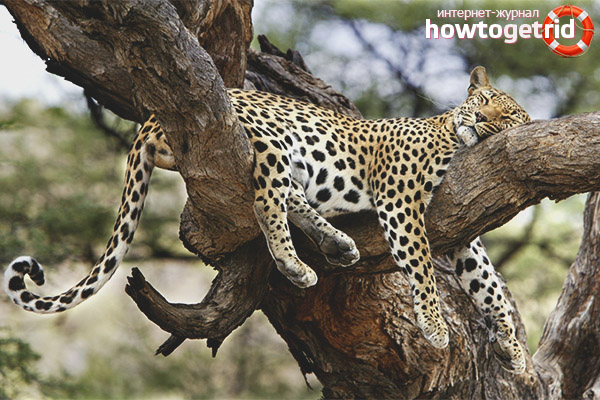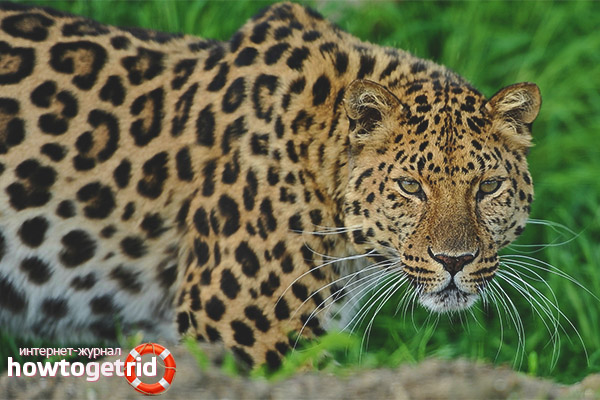The content of the article
The leopard is classified as a feline family and is considered a predatory mammal. To date, all representatives have been studied quite extensively, so there is no difficulty in finding reliable information. We will consider where these individuals live, what they prefer to eat, what are their external characteristics, etc. You can form your own opinion.
Description
- These large cats differ in size from tigers and lions. By the way, the last animals are much more. If you follow the observations of experts, the females are slightly smaller than the males, about a third of the body. The body is muscular and elongated in format, it is compressed from the side parts, it looks quite slim and flexible.
- The tail is elongated, occupies more than half the length of the body. Limbs shortened, but strong and muscular. The claws are light, oblate with lateral sides, strongly bent.The head has a relatively small size, rounded in format. The forehead bulges, in the front of the elongation is noticeable.
- The ears are rounded in shape, of medium size, set at a decent distance from each other. Round eyes of small diameter, the pupil is also round. Vibrissae are similar in appearance to black hairs, they can be black and white or pure white. The length stretched to 10 cm and more.
- As for the general description of the animal, its final characteristics depend on what gender a particular individual belongs to. Also important is the area of distribution and food. Those cats that live in forest parts, slightly less individuals living in open areas.
- The length of the body of an adult leopard, with the exception of the tail, is 1-2 meters. The tail is extended up to 1 m. And even more. By weight, adult members of the family reach 35-60 kg. (females) and 60-73 kg. (individual males). Height at withers varies between 46 cm. (Females) and 75 cm. (Males).
- There are no distinctive signs on a sex. They only appear in the overall characteristics, so it is sometimes difficult to distinguish the young.We can only say that young females before puberty seem fragile, with an elongated and light head.
Wool cover
- As for the coat, it is shortened and relatively thick. Uniform in length on the entire body. It can be slightly lush in some areas when it comes to the cold season. Wool shortened and coarse. According to external data there are no special differences in summer and winter. However, winter clothing is slightly darker in pigmentation, dimmer and more even. Summer outfit is motley and bright.
- Considering the color, it is worth saying that there is a mass of its variations. Hue can vary, ranging from pale straw, ending bright red and even brown. Individuals of the Central Asian type are pigmented gray-beige, while leopards living in the Far East are colored yellow-red. Juveniles are lighter than adults.
- Pigmentation is modified in proportion to geographical habitat, nutrition, and many other aspects. Also the role is played by the season of the year. We emphasize that the pigmentation in the front section of the face without spots, while in the area of the whiskers there are light blotches. The area of the forehead, ears and eyes has black specks of the same size.The same can be said about the side parts of the neck, cheeks and areas behind the ears.
- The ears from the back section are pigmented with black. On the side parts of the case and on the back there are annular inclusions. They are located in the area above the shoulder blades and on the hips. The legs and the lower section of the abdominal region have solid and dark patches with clear contours. The tail is decorated with ring-lines that literally twist around it. Stains may be observed instead of lines. Again, the formation of spots and their characteristics are directly dependent on the individual, this coloring is strictly individual.
- Those leopards who prefer to dwell in the south-eastern part of Asia, otherwise called black panthers. They are not completely pigmented with black, but the large pigmentation section has exactly that color. The fur is thick, darkened, which allows individuals to mask themselves in their environment. Interestingly, such leopards can appear simultaneously with speckled offspring. They are more aggressive, mistrustful, detached.
- If we consider the population of mammals that is widespread on the island of Malacca, then more than half of the livestock is pigmented with black.The second part is occupied by animals, which revealed incomplete melanism. It is manifested in the fact that the spots are much larger and closer to each other.
Lifestyle
- These mammals prefer to hide from view and not show up. They live in remote areas, but do not go far from human habitation. Males by the nature of stay alone, while females raise offspring and are engaged in his upbringing.
- Each individual occupies its territory, the size depends on the arrogance and ability to win the land. As a rule, females can occupy up to 15 square meters. km Males are even bolder, they need about 50 square meters. km If individuals are opposite-sex, they can enter each other’s areas without fear of being expelled.
- There are special marks by means of which individuals mark their territory. They can mark trees, separate plots of land, etc. Only those zones that have been chosen for permanent residence and shelters are marked with Mocha. Almost all predators of this kind live in their environment constantly, they are not subject to migration.
- Some male bachelors can leave their homes and go on a journey.They walk along streams, climb trees and overcome water obstacles. If a larger predator is ahead, the leopard will climb up and wait out.
- Most often, leopards equip their homes on the slopes. Such an arrangement of houses allows predators to have an excellent overview of the entire territory. Individuals often use caves, rock canopies, stone placers and even basal hollows of trees as shelters.
- Often, a predator can move in graceful strides. Often he gives way to a gallop. When such an animal starts to run, its speed can develop up to 60 km / h. In addition, cats jump to impressive distances. The length of the jump can be up to 7 m. Leopards are excellent swimmers. Therefore, if necessary, can overcome complex obstacles in the water.
- On average, wild cats live in the wild for about 10 years. With regard to the conditions of detention in a zoo or nursery, individuals live to 20 years without problems.
Diet
- All felines are real predators. Therefore, the basis of the diet mainly includes ungulates.Individuals most often hunt deer, antelope and deer. If there is not enough food in nature, cats can easily eat different rodents.
- In addition, leopards attack monkeys, birds and even reptiles. Sometimes these predators attack domestic dogs and livestock. Moreover, if the leopard is not disturbed, it will not attack the person. Otherwise, there were also such cases when inexperienced hunters or tourists became victims of wild cats.
- Large predators often attack foxes and wolves. If necessary, they do not even disdain carrion. Sometimes it can be observed that leopards steal food even from other predators. In addition, the individuals in question try to lead a single lifestyle. When hunting, the cat sits in ambush or quietly sneaks up.
Breeding
- Individuals living in the southern territories are able to breed throughout the year. This applies to any subspecies of leopards. Predators that live in the Far East, begin reproduction in late autumn or early winter.
- In any case, during the mating season, breeding of wild cats is accompanied by the fact that the males roar loudly.Often you can watch fights between males for the attention of females. This behavior is inherent only in mature individuals. Juveniles always stand aside.
- It is worth noting an interesting fact, young wild cats grow and develop much faster than tiger cubs. Therefore, at the age of 3 years, leopards gain full size. In addition, they begin puberty. However, the females mature a little earlier.
- After mating, the female bears offspring for 3 months. And in the end, only 2 babies are born, more often 1. Newborn cats are completely defenseless and blind. At this time, the female tries to hide the young in caves and crevices. In advance adult cats equip their home.
The enemies
The greatest danger to wild cats are wolves. The problem is that such individuals prefer to mainly keep in flocks. Therefore, in an area where there are a small number of trees, leopards are in particular danger. Individuals often clash with hyenas, lions, bears and tigers. However, the greatest threat to the leopard is a man.
It is worth noting that the largest population of such cats is in the African expanses.And leopards are found in the mountains, savannas, jungles and semi-deserts. They are not found only in the Sahara. Subspecies of such wild cats are spread all over the world. They can be found in the Far East in India, China, Sri Lanka and many other places.
Video: Leopard (Panthera pardus)













To send